
We are celebrating 15 years — and counting — of stories that are deeply researched and deeply felt, that build a historical record of what the city has been.
We are celebrating 15 years — and counting — of stories that are deeply researched and deeply felt, that build a historical record of what the city has been.
Typecast is a long-term investigation by the Architectural League into architectural typologies that seeks to move beyond stereotypes of architectural form by illuminating the social and spatial realities – and specific urban potential – of distinct sites that share certain physical characteristics and philosophies of design but differ greatly in their lived experience.
This Saturday, May 4th, the Architectural League of New York / Urban Omnibus tent at the IDEAS CITY StreetFest will host a pop-up exhibition that sketches the project’s broad research agenda in terms of five examples, one in each of the boroughs, of a particular housing typology, “towers-in-the-park.” The exhibit will include photographs, figure-ground drawings, and a preliminary set of research questions. This year, the festival’s theme is “Untapped Capital,” and Typecast seeks to make visible the under-recognized spatial and social capital in these developments, to recast them as assets rather than liabilities, and to illuminate some of the ways in which social activity and physical form influence each other. In so doing, we hope to support efforts to modify and improve elements of our shared built environment in accord with citizens’ needs and desires for sustainable and generative urban living.
Be sure to come visit us this Saturday — the Architectural League / Urban Omnibus booth will be located on the corner of Chrystie and Stanton in Sara Delano Roosevelt Park — but first, take a look at some original photography of our initial study sites here and read more about the thinking behind the project below. — C.S. & A.W.
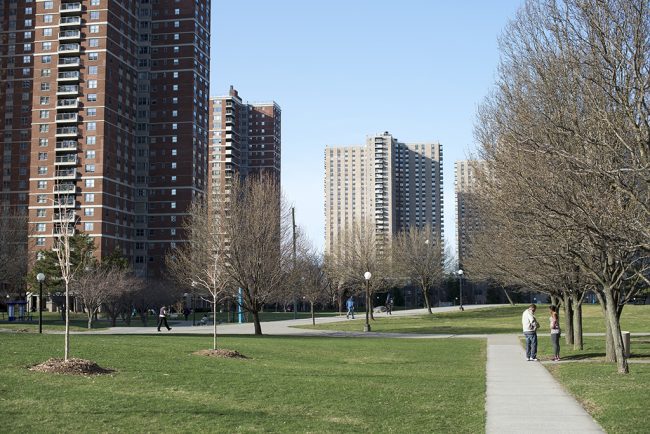
Co-op City, Bronx | Photo by Amani Willett
On Typecasting
Sometimes actors become pigeonholed into a particular genre of film or a particular character, repeatedly cast based on how they look or the roles they’ve played in the past. The set, story, cast, and crew may change, but the typecast actor seems predestined to play the same part again and again.
Buildings can fall prey to the same tendency. Specific and recurring approaches to site planning, building form, use, and materials manifest themselves as shared physical attributes. And these come to signify, in the public imagination, shared social characteristics. We cease to see the variations between projects, and instead apply the same label – and the same connotations – to different kinds of built projects with similar traits. We typecast them.
Typecast is a long-term, research-based study into building typologies that seeks to refresh thinking about architectural typologies that have come to be seen as outdated, urban leftovers from bygone eras. While technologies progress and policies and priorities shift, our understanding of building typologies tends to remain static and unresponsive. Rather than allow them to slip into the background, Typecast attempts to bring new perspectives to existing types, rethinking how they can best nurture contemporary ways of living in the city.
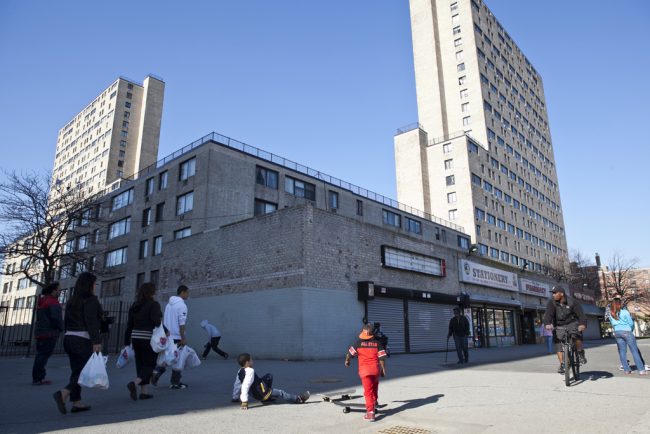
SeaRise, Coney Island, Brooklyn | Photo by David Lang
In many ways, New York City operates as a laboratory of ideas for dense urban living. The city is home to a diverse array of housing typologies that range from single-family ranch homes and split-levels to brownstones and apartment buildings of all shapes and sizes. As distinct as these types are, what all of them share is their relationship to the street: no matter how tall or how far apart they are, the majority of our city’s building stock is oriented towards our greatest public space, our streets and avenues. One particular type of housing that diverges from this pattern is what is commonly referred to as “towers-in-the-park.” The term refers to an architectural and urban design typology of multi-family, high-rise housing complexes located on a “superblock”: a dedicated area of open space disconnected from the street system. The deficits of this typology are well known, such as the perceived association with concentrated poverty or the absence of street-life integration. However, their particular assets — including opportunities for productive ecological planning, convenient elder living, minimal site coverage and the uniform access to light and air that comes with it, and open space programming — are not broadly understood or thoroughly explored. Previous Urban Omnibus features, such as “Making Connections: Planning for Green Infrastructure in Two Bridges,” “NORCs in NYC,” “Starrett City: A Home of One’s Own — With Party Walls,” and “A Few Days in the Bronx: From Co-op City to Twin Parks,” have chronicled the environmental, social, and architectural potential of towers-in-the-park. Typecast will marshal this body of analysis and move it forward, introducing visual, ethnographic, and sociological lines of inquiry into a conversation about the relationship of use and form, design and experience, and urban history and urban futures.
On a more immediate level, the tower-in-the-park type is currently attracting newfound attention in planning, housing, and real estate circles. Towers-in-the-park are particularly prevalent among New York City Housing Authority (NYCHA) projects. As NYCHA struggles to find ways to meet operating and maintenance costs for its projects in the face of declining federal subsidies, the development potential of the open space within NYCHA sites has come to be seen as an opportunity to leverage an asset that the Authority already owns.
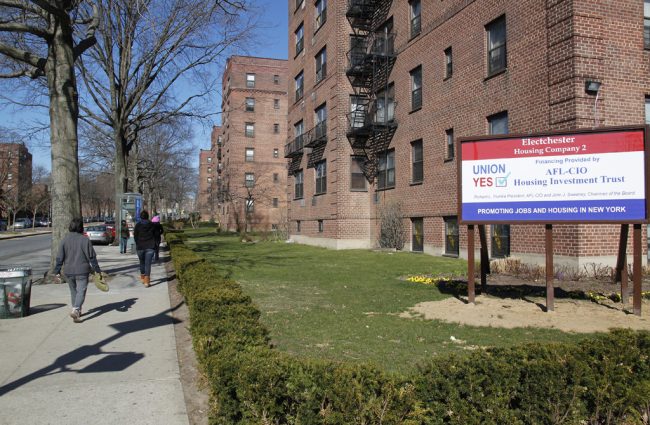
Electchester, Queens | Photo by Cameron Blaylock
But the typology is by no means exclusive to public housing. Labor unions and large-scale private developers have also, at various times, seen the towers-in-the-park model as an efficient and effective way to house large numbers of people. How these buildings’ communities of residents – as well as their tenancy and financing models – have evolved over time is just as central to their story as their architecture and urban design. Close reading of the realities behind the apparent homogeneity of building type can reveal important spatial as well as social distinctions and make vivid the specificities of the residents who use and inhabit these sites. These nuances are key to understanding not only the history of each site but its future potential as a productive landscape.
With this need for a closer look in mind, the first phase of Typecast delves into five very different towers-in-the-park: Co-op City (Baychester and Eastchester, The Bronx); Sea Rise and Sea Park East (Coney Island, Brooklyn); Todt Hill Houses (Castleton Corners, Staten Island); Electchester (Pomonok, Queens); and Alfred E. Smith Houses (Two Bridges, Manhattan). Each of these sites occupies a completely distinct urban geography. They vary widely in scale, population, and demographic make-up. Co-op City and Electchester were developed by unions. Sea Rise and Sea Park East were developed by New York State’s Urban Development Corporation. Todt Hill and Smith Houses are NYCHA projects. And all of them have undergone significant changes in the decades since they were built, either in their own internal make-up or in the urban conditions surrounding them.
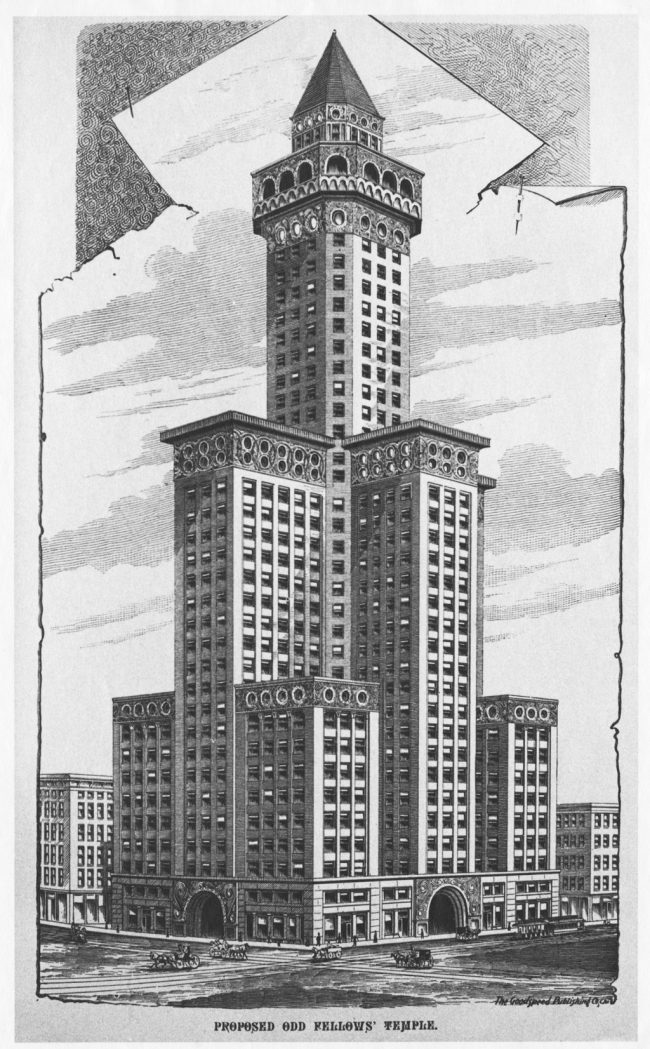
Fraternity Temple, Chicago, IL, 1891. Adler and Sullivan, designers. Richard Nickel Archive, Ryerson and Burnham Archives, The Art Institute of Chicago
Evolution of the tower-in-the-park
The evolution of the tower-in-the-park as a typology progressed in fits and starts, beginning as unrealized projects on paper and touching the ground decades later as public housing projects in American cities. Many tower-in-the-park schemes assume a cruciform building plan, dating back to Louis Sullivan’s design for the unbuilt Fraternity Temple project in Chicago in 1891. While Sullivan fills out the urban block, Le Corbusier and Auguste Perret isolate the building from the street, leaving only a cleanly extruded cruciform plan surrounded by green fields. This concept reached its formal pinnacle in Le Corbusier’s “La Ville Contemporaine” in 1925, in which a vacant, flat ground plane is punctured by repeating, 60-story, equally spaced cruciform skyscrapers. Characterized as an alternative to the endless street canyons of Manhattan, this diagram became the tool to introduce a radical departure in planning. The street wall and urban disorder of pedestrians were gone; green fields and the dominance of the highway had arrived.

The Plan Voisin, Paris | Image via Density Atlas
When this diagram was applied to an existing urban context, it didn’t so much integrate with the existing city as obliterate it. As the accomplice of this new planning diagram, automobile manufacturer Voisin sponsored the exhibition in which it was unveiled and lent its name to the plan. Le Corbusier’s “Plan Voisin” placed this newly conceived urban form in the center of Paris, erasing the past for the sake of the future. As the first and most extreme incarnation of the tower-in-the-park typology, the scheme not only emphasized the purity and height of the towers, but the lushness of the landscape surrounding them — something that is more apparent in Le Corbusier’s drawings than in his models.
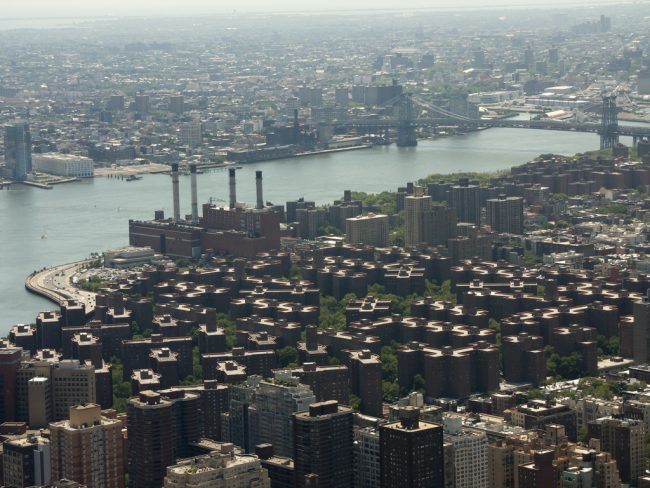
Stuyvesant Town, Manhattan | Photo by Wendel Fisher
The tower-in-the-park typology, originally conceived as applicable to a wide range of income levels, became the default form for public housing in the United States. Projects widely regarded as failures, such as Pruitt-Igoe in St. Louis, dominated headlines, and the architecture was held responsible for the social challenges that followed post-industrial shifts in urban economies and labor pools. Meanwhile, the attention focused on more successful projects, such as Stuyvesant Town on the East Side of Manhattan, did not cite the form of the building as a determinant of positive potential. Thus, the dominant public perception of the towers was as physical containers of urban blight, their parks desolate, crime-ridden landscapes. The reality, as usual, is much more complex. The typology has been modified in many ways, with tower-in-the-park buildings and sites morphing in scale, building height, shape, orientation, site coverage, ownership models, and open space programming. Moreover, this model can and does host vastly different communities with a similar set of planning assets. An immediately noticeable difference between sites is density: with 121 dwelling units per acre, the highrise Plan Voisin is much less dense than mid-rise Clinton Hill Co-op in Brooklyn at 195 dwelling units per acre, but much more dense than Co-op City — the largest cooperative development in the world — at 48 dwelling units per acre.
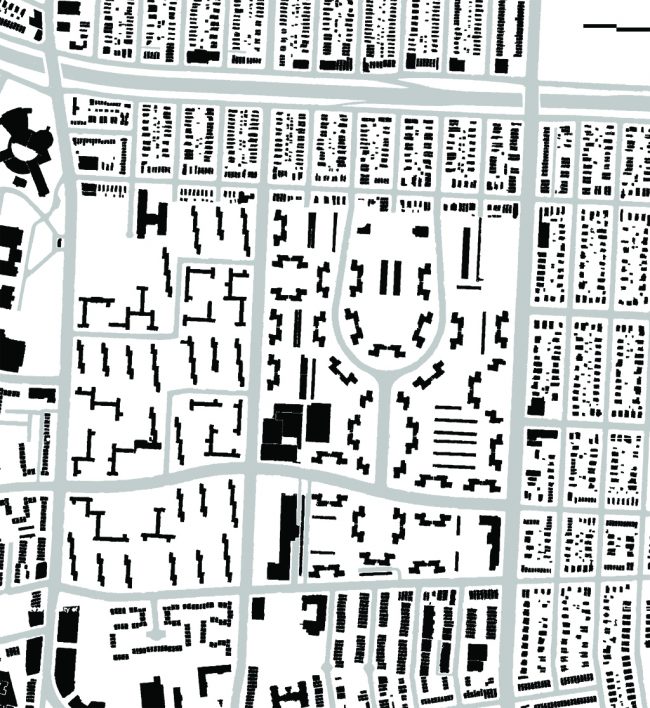
Pomonok Houses and Electchester, Queens | Graphic by Andrew Wade
Form and Experience
Figure-ground diagrams — a kind of drawing that architects and urban designers use to understand the relationship of buildings and open space — demonstrate that, despite the diversity in detail among various projects described above, there are common traits that towers-in-the-park projects share. By representing built space in black and open space in white, the diagram distills the “grain” of the city. The relative size and mass of buildings becomes apparent, as does the space between them. While the figure-ground of a traditional urban form shows buildings clearly lining both sides of streets, filling in solid blocks between street corners, the figure-ground of a tower-in-the-park development shows how it disrupts this pattern, revealing buildings that float in space rather than shape it by defining roadways and sidewalks. Le Corbusier lined up his cruciform towers in an immediately legible orthogonal grid, but the realities of building in an extant city meant not all towers-in-the-park adhered to such precision or predictability. Nonetheless, the type’s perceived advantage was its independence from existing urban grain, allowing it to function — in theory — as a tabula rasa thought experiment, free from the accretive constraints of previous generations of citymaking.
But constraints, of course, also present opportunities. And while contemporary perspectives might disapprove of single-use building complexes divorced from their immediate urban context, towers-in-the-park are an undeniable part of our built environment. The figure-ground diagram, so useful in describing the relationship between buildings and open space, fails to describe the ways the buildings’ users weave together the activities of the tower with those of the park. How users navigate and negotiate these spaces offers clues to how we can identify assets in our existing building stock. Typecast aims to do just that — to identify assets hidden in plain sight — as our city strives to adapt the urban landscape to meet contemporary needs.
Stay tuned for updates on Typecast in the coming weeks and months, and read our series of articles exploring Electchester, Alfred E. Smith Houses, Todt Hill Houses, Co-op City, and Sea Rise and Sea Park East (forthcoming):
“Electchester: A City Made for Workers” by Ari Paul
“Smith Houses: A Legacy of Activism” by Sarika Bansal
“A Scheme on a Bluff: The View from Todt Hill Houses” by Brad Fox
“Cooperative City, Cooperative Community” by Caitlin Blanchfield
The views expressed here are those of the authors only and do not reflect the position of The Architectural League of New York.
Comments